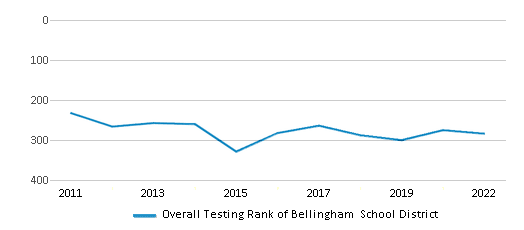For the 2025 school year, there is 1 public preschool serving 109 students in Bellingham School District.
Public Preschools in Bellingham School District have a diversity score of 0.44, which is less than the Massachusetts public preschool average of 0.68.
Minority enrollment is 27% of the student body (majority Hispanic and Asian), which is less than the Massachusetts public preschool average of 53% (majority Hispanic).
Overview
This School District
This State (MA)
# Schools
6 Schools
567 Schools
# Students
1,990 Students
205,303 Students
# Teachers
155 Teachers
17,796 Teachers
Student : Teacher Ratio
13:1
13:1
District Rank
Bellingham School District, which is ranked within the bottom 50% of all 393 school districts in Massachusetts (based off of combined math and reading proficiency testing data) for the 2021-2022 school year.
The school district's graduation rate of 85-89% has decreased from 90-94% over five school years.
Overall District Rank
#284 out of 397 school districts
(Bottom 50%)
(Bottom 50%)

Math Test Scores (% Proficient)
34%
41%

Reading/Language Arts Test Scores (% Proficient)
35%
44%

Science Test Scores (% Proficient)
41%
44%

Graduation Rate
85-89%
90%

Students by Ethnicity:
Diversity Score
0.38
0.68
# American Indian Students
4 Students
495 Students
% American Indian Students
n/a
n/a
# Asian Students
60 Students
11,779 Students
% Asian Students
3%
6%
# Hispanic Students
265 Students
61,622 Students
% Hispanic Students
13%
30%
# Black Students
49 Students
25,280 Students
% Black Students
3%
12%
# White Students
1,543 Students
95,698 Students
% White Students
78%
47%
# Hawaiian Students
6 Students
173 Students
% Hawaiian Students
n/a
n/a
# Two or more races Students
63 Students
10,168 Students
% of Two or more races Students
3%
5%
Students by Grade:
# Students in PK Grade:
109
31,316
# Students in K Grade:
127
33,369
# Students in 1st Grade:
138
30,795
# Students in 2nd Grade:
125
28,908
# Students in 3rd Grade:
125
23,512
# Students in 4th Grade:
149
22,524
# Students in 5th Grade:
141
18,693
# Students in 6th Grade:
141
7,489
# Students in 7th Grade:
160
3,111
# Students in 8th Grade:
148
3,363
# Students in 9th Grade:
165
606
# Students in 10th Grade:
158
525
# Students in 11th Grade:
145
528
# Students in 12th Grade:
152
485
# Ungraded Students:
7
79
District Revenue and Spending
The revenue/student of $24,102 is higher than the state median of $23,845. The school district revenue/student has stayed relatively flat over four school years.
The school district's spending/student of $24,571 is less than the state median of $24,602. The school district spending/student has stayed relatively flat over four school years.
Total Revenue
$48 MM
$21,850 MM

Spending
$49 MM
$22,544 MM

Revenue / Student
$24,102
$23,845

Spending / Student
$24,571
$24,602

Best Bellingham School District Public Preschools (2025)
School
(Math and Reading Proficiency)
(Math and Reading Proficiency)
Location
Grades
Students
Rank: n/an/a
342 Hartford Avenue
Bellingham, MA 02019
(508) 966-2512
Bellingham, MA 02019
(508) 966-2512
Grades: PK
| 109 students
Recent Articles

What Is A Charter School?
Explore the world of charter schools in this comprehensive guide. Learn about their history, how they operate, and the pros and cons of this educational innovation. Discover key facts about charter schools, including admission policies, demographics, and funding, as well as what to look for when considering a charter school for your child.

10 Reasons Why High School Sports Benefit Students
Discover the 10 compelling reasons why high school sports are beneficial for students. This comprehensive article explores how athletics enhance academic performance, foster personal growth, and develop crucial life skills. From improved fitness and time management to leadership development and community representation, learn why participating in high school sports can be a game-changer for students' overall success and well-being.

February 05, 2025
Understanding the U.S. Department of Education: Structure, Impact, and EvolutionWe explore how the Department of Education shapes American education, from its cabinet-level leadership to its impact on millions of students, written for general audiences seeking clarity on this vital institution.





